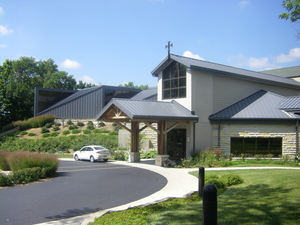 The Sacrifice of the Mass celebrated at the Monastery of the Glorious Cross,
The Sacrifice of the Mass celebrated at the Monastery of the Glorious Cross,
Category: Benedictines
Cistercian nun leaves monastery to visit Pope Benedict, first time in 84 years
 A Cistercian nun at 103 years, is leaving the monastery for the first time in 84 years to meet Pope Benedict while he’s in Spain for World Youth Day.
A Cistercian nun at 103 years, is leaving the monastery for the first time in 84 years to meet Pope Benedict while he’s in Spain for World Youth Day.
Attention in Prayer
This morning on my train ride into the City, I was reading a monograph by Archabbot Lambert Reilly, OSB, the emeritus archabbot of St Meinrad Archabbey, “Prayer: A Conversation with God.” I recommend it. Why? Because I need to be reminded that prayer is not a monologue but a dialogue; it is the heart speaking to the Heart. I also have to remember it is not about me exclusively but about Him who is greater than I.
Monasteries are true and proper oases for humanity, Benedict XVI reminds us
In Wednesday’s edition of L’Osservatore Romano, Pope Benedict told the listeners of the Wednesday General Audience that the monastic life is an essential value for humanity and for the Church, today. The Pope’s emphasis on beauty and silence helps us to appreciate and to listen God’s promptings of the desires of the heart is important. Let’s pay attention to what the Pope has to say. You may also want to watch the Rome Reports news video.
The editor writes, “Monasteries are true and proper oases of the spirit in which God speaks to humanity. The Pope said this to faithful at the General Audience of Wednesday, 10 August, that was held in the courtyard of the Papal Residence at Castel Gandolfo.”
 Dear Brothers and Sisters! In every age, men and women who have consecrated their lives to God in prayer – like monks and nuns – have established their communities in particularly beautiful places: in the countryside, on hilltops, in valleys, on the shores of lakes or the sea, or even on little islands. These places unite two elements which are very important for contemplative life: the beauty of creation, which recalls that of the Creator, and silence, which is guaranteed by living far from cities and the great means of communication. Silence is the environmental condition that most favors contemplation, listening to God and meditation. The very fact of experiencing silence and allowing ourselves to be “filled,” so to speak, with silence, disposes us to prayer. The great prophet, Elijah, on Mount Horeb – that is, Sinai – experienced strong winds, then an earthquake, and finally flashes of fire, but he did not recognize the voice of God in them; instead, he recognized it in a light breeze (cfr. 1 Rev 19:11-13). God speaks in silence, but we need to know how to listen. This is why monasteries are oases in which God speaks to humanity; and there we find the courtyard, a symbolic place because it is a closed space, but open toward the sky.
Dear Brothers and Sisters! In every age, men and women who have consecrated their lives to God in prayer – like monks and nuns – have established their communities in particularly beautiful places: in the countryside, on hilltops, in valleys, on the shores of lakes or the sea, or even on little islands. These places unite two elements which are very important for contemplative life: the beauty of creation, which recalls that of the Creator, and silence, which is guaranteed by living far from cities and the great means of communication. Silence is the environmental condition that most favors contemplation, listening to God and meditation. The very fact of experiencing silence and allowing ourselves to be “filled,” so to speak, with silence, disposes us to prayer. The great prophet, Elijah, on Mount Horeb – that is, Sinai – experienced strong winds, then an earthquake, and finally flashes of fire, but he did not recognize the voice of God in them; instead, he recognized it in a light breeze (cfr. 1 Rev 19:11-13). God speaks in silence, but we need to know how to listen. This is why monasteries are oases in which God speaks to humanity; and there we find the courtyard, a symbolic place because it is a closed space, but open toward the sky.
 Tomorrow, dear friends, we will celebrate the memory of St. Clare of Assisi. So I would like to recall one of these “oases” of the spirit which is particularly dear to the Franciscan family and to all Christians: the little convent of San Damiano, situated just beneath the city of Assisi, among the olive groves that slope towards Santa Maria degli Angeli. In that little church, which Francis restored after his conversion, Chiara and her first companions established their community, living off prayer and little works. They were called the “Poor Sisters,” and their “form of life” was the same as the Frati Minori: “To observe the Holy Gospel of our Lord Jesus Christ” (Rule of St. Clare, I, 2), conserving the union of reciprocal charity (cfr ivi, X, 7) and observing in particular the poverty and humility of Jesus and his Most Holy Mother (cfr, ivi, XII, 13).
Tomorrow, dear friends, we will celebrate the memory of St. Clare of Assisi. So I would like to recall one of these “oases” of the spirit which is particularly dear to the Franciscan family and to all Christians: the little convent of San Damiano, situated just beneath the city of Assisi, among the olive groves that slope towards Santa Maria degli Angeli. In that little church, which Francis restored after his conversion, Chiara and her first companions established their community, living off prayer and little works. They were called the “Poor Sisters,” and their “form of life” was the same as the Frati Minori: “To observe the Holy Gospel of our Lord Jesus Christ” (Rule of St. Clare, I, 2), conserving the union of reciprocal charity (cfr ivi, X, 7) and observing in particular the poverty and humility of Jesus and his Most Holy Mother (cfr, ivi, XII, 13).
Benedict XVI at the General Audience stresses the value of monastic spirituality God speaks in silence Benedict XVI at the General Audience stresses the value of monastic spirituality God speaks in silence and beauty of the place in which the monastic community lives – simple and austere beauty – are like a reflection of the spiritual harmony which the community itself attempts to create. The world is filled with these oases of the spirit, some very ancient, particularly in Europe; others are more recent, while still others have been restored by new communities. Looking at things from a spiritual perspective, these places of the spirit are a load-bearing structure of the world! It is no accident that many people, especially in times of rest, visit these places and stop there for some days: even the soul, thanks be to God, has its needs! The Pope continues:
Let us remember, therefore, St. Clare. But let you also remember other Saints who remind us of the importance of turning our gaze to the “things of heaven,” like St. Edith Stein, Teresa Benedicta of the Cross, Carmelite, co-patron of Europe, whom we celebrated yesterday. And today, August 10, we cannot forget St. Lawrence, deacon and martyr, with a special wish for Romans who have always venerated him as one of their patrons. Finally, let us turn our gaze to the Virgin Mary, that she may teach us to love silence and prayer.
Father Anselm Atkinson, OSB New Abbot of Pluscarden
 The Rt. Rev. Anselm Atkinson, OSB until now the
The Rt. Rev. Anselm Atkinson, OSB until now the
Superior of St. Mary’s Monastery, Petersham, MA (for the last 21 years) and Abbot-Visitor for the
English speaking province of the Subiaco Congregation of the Order of St.
Benedict has been elected as the third Abbot of Petersham’s motherhouse and the
monastery of his profession (1976) and priest in 1982, Pluscarden Abbey in Scotland. Pluscarden was refounded in 1948.
Hugh Gilbert, OSB who will be ordained and installed on August 15 as the Bishop
of Aberdeen.
Vincent Bataille elected new abbot president of the Swiss American Congregation of Monks
 Abbot Vincent de Paul Bataille, emeritus abbot of
Abbot Vincent de Paul Bataille, emeritus abbot of
Marmion Abbey, was elected for six-year term by the capitulars of the 44th General Congregation Swiss American Congregationon Monday, August 8, 2011. As the new Abbot President he’ll over see certain parts of the monastic life of little more than a dozen monasteries (see a previous blog post).
renovation of Marmion Abbey, the building of the abbey church, and attracting
new vocations to the abbey, plus several additions to the academy. He earned the MA (Music) University of Notre Dame,
MEd from DePaul University,
Chicago. He taught Math and Language at Marmion Academy, and held the position
of Dean of Students at the Academy.
of Priory of San José, Guatemala before being elected the 4th Abbot of Marmion Abbey
and President of Marmion Academy, Aurora, Illinois, in 1991. Until now he’s been the Vocation
Director for Marmion Abbey, and a member of the Abbot President’s Council,
Swiss-American Congregation.
Monks in the Newark hood
 The Newark, New Jersey colony of Benedictine monks have been involved with the teaching of youth and parish work since their founding in 1857. The monks, priests and brothers, live a life of prayer, work within the context of the fraternal life that engages one’s freedom to serve the Lord in unique ways.
The Newark, New Jersey colony of Benedictine monks have been involved with the teaching of youth and parish work since their founding in 1857. The monks, priests and brothers, live a life of prayer, work within the context of the fraternal life that engages one’s freedom to serve the Lord in unique ways.
Benedictine abbots meet
 Today begins the 44th General Chapter of the Swiss American Benedictine Congregation. The ruling abbots and conventual priors with elected delegates will be at Westminister Abbey in Mission British Columbia, Canada.
Today begins the 44th General Chapter of the Swiss American Benedictine Congregation. The ruling abbots and conventual priors with elected delegates will be at Westminister Abbey in Mission British Columbia, Canada.
German Benedictines prepare for Benedict’s visit
 In this photo taken July 28, 2011 Sister Placida scales hosts at the Benedictine Abbey of St. Gertrud’s host bakery in Alexanderdorf, Germany, about 50 kilometers (31 miles) south of Berlin. Pope Benedict XVI will not visit the Benedictine Abbey of St. Gertrud, but preparations for his trip are nevertheless in full swing, with the nuns baking thousands of communion wafers to be blessed by the pope at Masses during his September tour. (Photo/Markus Schreiber)
In this photo taken July 28, 2011 Sister Placida scales hosts at the Benedictine Abbey of St. Gertrud’s host bakery in Alexanderdorf, Germany, about 50 kilometers (31 miles) south of Berlin. Pope Benedict XVI will not visit the Benedictine Abbey of St. Gertrud, but preparations for his trip are nevertheless in full swing, with the nuns baking thousands of communion wafers to be blessed by the pope at Masses during his September tour. (Photo/Markus Schreiber)
Quilting ladies of St Benedict’s Abbey, Benet Lake
 Benedictine abbeys are places where the culture of prayer, study, charitable work and arts and crafts can breathe with ease. That’s the genius of Saint Benedict and the leadership of monasticism through 1500 years. Few religious orders have such an expansive sense of culture as the Benedictines (or share in across the world). Art aids one in his or seeking God and a better sense of self.
Benedictine abbeys are places where the culture of prayer, study, charitable work and arts and crafts can breathe with ease. That’s the genius of Saint Benedict and the leadership of monasticism through 1500 years. Few religious orders have such an expansive sense of culture as the Benedictines (or share in across the world). Art aids one in his or seeking God and a better sense of self.
Continue reading Quilting ladies of St Benedict’s Abbey, Benet Lake
